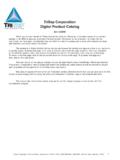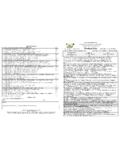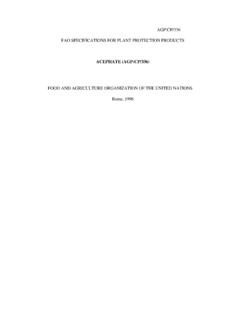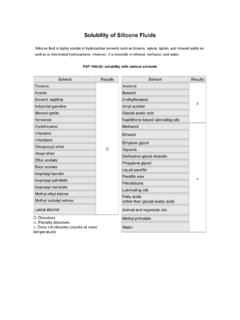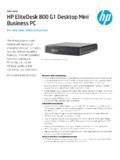Transcription of MILK and dairy products - Food and Agriculture …
1 milk and dairy products in human nutrition Technical Editors Ellen Muehlhoff Senior Officer Nutrition Division Anthony Bennett Livestock Industry Officer Rural Infrastructure and Agro-Industries Division Deirdre McMahon Consultant Nutrition Division milk and dairy products in human nutrition FOOD AND Agriculture ORGANIZATION OF THE UNITED NATIONS Rome, 2013. Cover photo credits front: EADD/Neil Thomas (top), FAO/A. Conti (bottom). back: ILRI/Apollo Habtamu (top), courtesy of Heifer International (mid), World Bank/Ray Witlin (bottom). The designations employed and the presentation of material in this information product do not imply the expression of any opinion whatsoever on the part of the Food and Agriculture Organization of the United Nations (FAO) concerning the legal or development status of any country, territory, city or area or of its authorities, or concerning the delimitation of its frontiers or boundaries.
2 The mention of specific companies or products of manufacturers, whether or not these have been patented, does not imply that these have been endorsed or recommended by FAO in preference to others of a similar nature that are not mentioned. The views expressed in this information product are those of the author(s) and do not necessarily reflect the views or policies of FAO. ISBN 978-92-5-107863-1 (print). E-ISBN 978-92-5-107864-8 (PDF). FAO 2013. FAO encourages the use, reproduction and dissemination of material in this information product . Except where otherwise indicated, material may be copied, downloaded and printed for private study, research and teaching purposes, or for use in non-commercial products or services, provided that appropriate acknowledgement of FAO as the source and copyright holder is given and that FAO's endorsement of users' views, products or services is not implied in any way.
3 All requests for translation and adaptation rights, and for resale and other commercial use rights should be made via request or addressed to FAO information products are available on the FAO website ( publications) and can be purchased through iii Contents Preface xii Foreword xiii Acknowledgements xv Abbreviations and acronyms xviii Contributors xxi Chapter 1. Introduction 1. Nutrition and health 1. Progress in nutrition outcomes 1. Undernourishment 1. Childhood undernutrition 2. Micronutrient malnutrition 2. The double burden of malnutrition 3. Linking Agriculture and nutrition 4. The role of milk and dairy products 5. dairy programmes affecting nutrition 7. Linking dairy Agriculture and nutrition 7. References 9. Chapter 2. milk availability: Current production and demand and medium-term outlook 11.
4 Abstract 11. Trends in food consumption patterns the role of livestock and dairy products 11. Drivers of increasing consumption of milk and livestock products 20. Trends in milk production patterns 22. Effects of technological changes on milk production and processing 26. Trends in international trade in livestock products 28. Future trends in production and consumption of dairy products 30. iv Emerging issues and challenges 32. Impact on the environment 33. Impacts on animal and human health 34. Challenges for smallholder production and poverty alleviation 34. Conclusion 35. Key messages 35. References 37. Chapter 3. milk and dairy product composition 41. Abstract 41. Introduction 41. milk composition 43. The role of milk as a source of macronutrients 43. Composition of milks consumed by humans 44.
5 Factors affecting milk composition 59. Nutritional value of milk from various species 60. Treated liquid milks and dairy products 64. milk classifications 66. Heat treatments and microbiocidal measures 70. Fermented milk products 74. Cheese 78. Butter and ghee 84. Cream 85. Whey products 86. Casein 88. milk products from milk from underutilized species 88. Key messages 89. Issues and challenges 90. References 90. Chapter 4. milk and dairy products as part of the diet 103. Abstract 103. Introduction 104. Limitations of studies reviewed 105. Interpreting study results 106. milk as a source of macro- and micronutrients 106. Dietary dairy in growth and development 111. Studies on the effect of milk and dairy products on linear growth in undernourished or socio-economically underprivileged children 113.
6 The role of milk and dairy products in treatment of undernutrition 116. milk in the diets of well-nourished children 117. Secular trend of increasing adult height 119. Possible mechanisms for growth-stimulating effects of milk 120. v Dietary dairy and bone health 121. Bone growth 121. Dietary factors that affect bone health 122. milk and dairy foods and bone health 125. Bone-remodelling transient 128. Limitations of studies using bone mineral density as an end point 128. Osteoporosis 128. Calcium-deficiency rickets 131. Summary 132. Dietary dairy and oral health 134. dairy intake, weight gain and obesity development 135. Dietary patterns and the risk of obesity 135. Association between dairy intake and weight status 136. dairy as part of a weight loss strategy 138. dairy intake, metabolic syndrome and type 2 diabetes 139.
7 dairy intake and cardiovascular disease 141. Effects of dietary fat on cardiovascular disease 142. Studies that support reducing animal products and the argument for low-fat versus high-fat dairy products 143. Recent review studies on milk / dairy consumption with respect to cardiovascular disease 146. Other dairy products and risk of cardiovascular disease 151. Summary 152. dairy intake and cancer 154. Colorectal cancer 154. Breast cancer 154. Prostate cancer 155. Bladder cancer 155. Childhood consumption of milk and dairy products and risk of cancer in adulthood 156. Recommendations by the World Cancer Research Fund/American Institute for Cancer Research 156. milk hypersensitivity 158. Lactose intolerance and malabsorption 159. milk -protein allergies 161. Current national recommendations for milk and dairy consumption 162.
8 Conclusion 163. References 164. Annex 183. Chapter 5. dairy components, products and human health 207. Abstract 207. Introduction 207. vi dairy components 209. milk fat and human health 209. milk protein and health 213. Lactose 216. dairy ingredients 216. dairy products 217. Fermented dairy products 217. Fortified milk and dairy products 219. From traditional to modern dairy foods 221. Regulatory health and nutrition claim framework and recent legislative developments 222. Conclusions 224. References 226. Annex 235. Chapter 6. Safety and quality 243. Abstract 243. Introduction 243. Food-safety hazards specific to milk and milk products 244. Biological hazards 245. Chemical hazards 248. Physical hazards 254. Health impact of outbreaks of food-borne illness attributed to milk and dairy products 255.
9 Assessing risk and prioritization of food-safety risks associated with milk and dairy products 256. Control and prevention: implementing safe food practices 260. Emerging issues 266. Key messages 266. Safety of milk and dairy products 266. Prevention/control 267. International guidance/controls 267. References 268. Chapter 7. milk and dairy programmes affecting nutrition 275. Abstract 275. Introduction 275. Sources and approach to the review 277. dairy production and Agriculture programmes 277. Africa 280. Asia and the Pacific 282. Summary 284. vii School-based milk programmes 284. Studies in Kenya and China 285. Asia and the Pacific 286. Summary 287. Fortified- milk programmes 288. Latin America and the Caribbean 288. Asia and the Pacific 289. Summary 290. milk powder and blended foods 290. Latin America and the Caribbean 291.
10 Africa 291. Summary 292. Key messages 293. References 294. Annex 299. Chapter 8. dairy -industry development programmes: Their role in food and nutrition security and poverty reduction 313. Abstract 313. Introduction 314. Income and employment generation 316. Employment generation in milk production 318. Employment generation in milk processing and marketing 320. Gender and household well-being 322. Education and knowledge 324. Food security, nutrition and health 327. Market intermediaries and consumers 330. Marketing systems and structures 331. Organization of milk producers 333. Trends in market demand 335. Regional and national patterns and approaches 335. Dairying in developed countries 335. Dairying in developing countries 336. Programmatic issues 341. Factors influencing success in dairy development projects 341.










